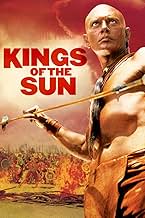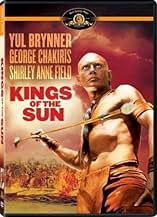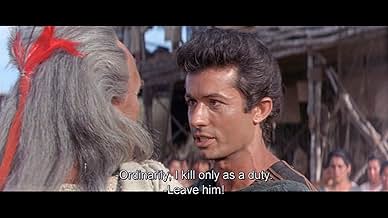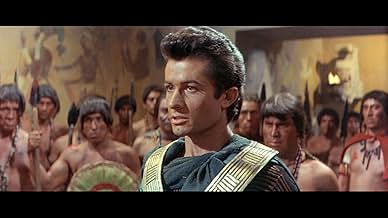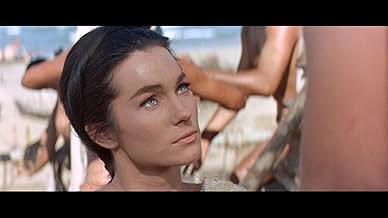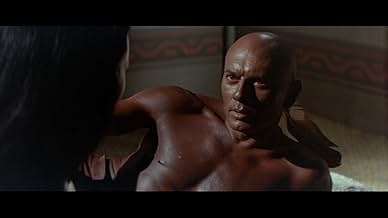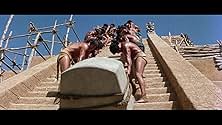AVALIAÇÃO DA IMDb
6,1/10
2,4 mil
SUA AVALIAÇÃO
Na costa do Golfo do México, a tribo indígena americana do Chefe Águia Negra se choca com a tribo Maia do Rei Balam.Na costa do Golfo do México, a tribo indígena americana do Chefe Águia Negra se choca com a tribo Maia do Rei Balam.Na costa do Golfo do México, a tribo indígena americana do Chefe Águia Negra se choca com a tribo Maia do Rei Balam.
- Direção
- Roteiristas
- Artistas
Victoria Vetri
- Ixzubin
- (as Victoria Vettri)
James Coburn
- Narrator
- (não creditado)
Chuck Hayward
- Indian Warrior Friend to Black Eagle
- (não creditado)
José Torvay
- Mayan Elder
- (não creditado)
Avaliações em destaque
Anyone interested in seeing Hollywood's version of the Maya should view this noted 60's entry. The film is punctuated with panoramic locations, magnificent sceneries and considerable numerical extras for sustained blockbuster effect. Entittled, " The Kings of the Sun ", this film is a worthy offering to entertain young and old alike. Assembled for the cast are Yul Brynner as Chief Black Eagle, George Chakiris as a Mayan Chiefton, Richard Basehart as a Mayan Priest and Shirley Anne Field as Ixchel, a beautiful princess. Accompanying this artistic rendering is it's rousing, nearly overpowering musical score composed by legendary Elmer Bernstine. The film depicts the story of a Mayan people amid its cultural throes in which Chakiris, replaces their dying king, but is forced to flee by a deadly rival menacingly played by Leo Gordon. Commandering an entire peaceful Mayan tribe on the hinterland of the Yucatan and sailing to the shores of America, Chakiris not only establishes a new beginning for his following, but collides culturally with Brenner and his Native American tribe. Aside from Eviserating cultural traditions, pummeling ancient deities and perhaps trampling on the Historical record, the film events are nevertheless worthy of tongue in cheek possibility. In the end, one can smile happily at this wonderful attempt and praise it for its dramatic sincerity. **** .
"Kings of the Sun" is a highly fictionalized story about the Mayan civilization of central America. The story has one of the last remaining Mayan groups fleeing to save their civilization. The Mayans were spread across much of modern day southern Mexico into other Central American countries. Others of their groups had been attacked and wiped out or conquered by an invading warring nation. We see clearly the distinction between the advanced civilization of the Mayans and the barbaric nature of their attackers. The movie doesn't give us a date or time frame, so it might have been any time in the latter Mayan period (100 to 700 A.D.). This was all well in advance of European discovery.
Many viewers today may not find this movie very interesting or entertaining. It is slow, for sure. There was considerable interest in ancient civilizations around the mid-20th century. And, a host of movies like this were made back then. Today we know more about the ancients, and Western interests for the most part seem to have shifted to the stars, space and the distant future. The fiction of the story here is only slightly interesting. The script isn't that good. Yul Bryner is probably the only good acting job, as Black Eagle. The rest of the cast are just so-so.
This movie has a number of conflicts with history. One has the invaders with iron weapons against the Mayans' wooden swords. In fact, there is little evidence of metal discoveries and development in the Americas. Only toward the middle of the second millennium is there some scant appearance of bronze objects. But, iron and steel appear only with the Europeans in the 16th century. That struck me as a strange thing that would belie history as well. If the Mayans were so advanced, and an agricultural society, why had they not discovered bronze or iron with which to make plows and other farming implements and tools? They hadn't yet in this movie, but the barbaric invaders had iron swords.
I note some of the reviews and correction comments that take issue with the Indian dress and tepees of Yul Bryner's tribe. But, I don't see or recall anything in the film that says the Mayans landed near the Mississippi Delta. The only evidence of any stream is a very small one. And, the vegetation that we see – trees and underbrush don't resemble anything like the moss-covered forests of Louisiana and the Bayou country. That area is very moist with considerable rainfall. But, this film has the Mayans reaching land in a dry area. So, I suggest that they would have landed in southeast Texas. They might have landed anywhere from present-day Corpus Christi to north of Galveston. That would have put them close to the lower range of the Comanche Indians. The Comanche where a fierce warring and hunting tribe that ranged across the Plains from southern Nebraska to central Texas. And, they built and slept in tepees. If one looks at a map of Gulf of Mexico, it's clear to see that the Mayans could have left the Yucatan Peninsula and sailed "across the sea," landing in southeast Texas.
At one point in the film, Black Eagle says that his people can learn much from the Mayans, and that the Mayans can learn from them. The Mayans are not hunters but farmers. We see them build a dam on a creek to divert the water to irrigate their crops. Archaeologists decades ago found irrigation ditches that had been used by the Hopi Indians of Arizona nearly 2,000 years ago. Then, in 2009 near Tucson, scientists discovered more ancient irrigation canals. Those had been used by ancestors of the Hopi in 1,200 B.C.
Many viewers today may not find this movie very interesting or entertaining. It is slow, for sure. There was considerable interest in ancient civilizations around the mid-20th century. And, a host of movies like this were made back then. Today we know more about the ancients, and Western interests for the most part seem to have shifted to the stars, space and the distant future. The fiction of the story here is only slightly interesting. The script isn't that good. Yul Bryner is probably the only good acting job, as Black Eagle. The rest of the cast are just so-so.
This movie has a number of conflicts with history. One has the invaders with iron weapons against the Mayans' wooden swords. In fact, there is little evidence of metal discoveries and development in the Americas. Only toward the middle of the second millennium is there some scant appearance of bronze objects. But, iron and steel appear only with the Europeans in the 16th century. That struck me as a strange thing that would belie history as well. If the Mayans were so advanced, and an agricultural society, why had they not discovered bronze or iron with which to make plows and other farming implements and tools? They hadn't yet in this movie, but the barbaric invaders had iron swords.
I note some of the reviews and correction comments that take issue with the Indian dress and tepees of Yul Bryner's tribe. But, I don't see or recall anything in the film that says the Mayans landed near the Mississippi Delta. The only evidence of any stream is a very small one. And, the vegetation that we see – trees and underbrush don't resemble anything like the moss-covered forests of Louisiana and the Bayou country. That area is very moist with considerable rainfall. But, this film has the Mayans reaching land in a dry area. So, I suggest that they would have landed in southeast Texas. They might have landed anywhere from present-day Corpus Christi to north of Galveston. That would have put them close to the lower range of the Comanche Indians. The Comanche where a fierce warring and hunting tribe that ranged across the Plains from southern Nebraska to central Texas. And, they built and slept in tepees. If one looks at a map of Gulf of Mexico, it's clear to see that the Mayans could have left the Yucatan Peninsula and sailed "across the sea," landing in southeast Texas.
At one point in the film, Black Eagle says that his people can learn much from the Mayans, and that the Mayans can learn from them. The Mayans are not hunters but farmers. We see them build a dam on a creek to divert the water to irrigate their crops. Archaeologists decades ago found irrigation ditches that had been used by the Hopi Indians of Arizona nearly 2,000 years ago. Then, in 2009 near Tucson, scientists discovered more ancient irrigation canals. Those had been used by ancestors of the Hopi in 1,200 B.C.
In 1963 there was a number of Hollywood fantasies based on historical and cultural themes that made the conoscenti cringe. I mean, Mayans migrating to the Gulf Coast, other Mayans using iron artifacts, arriving in the new world and speaking the same language as the locals? Well, back in those Hollywood days in the middle sixties, audiences were not quite so demanding as now. So, George Chakiris, fresh from his West Side Story triumph and Yul Brynner, known now from a number of hits, are pitched against each other in a sixty's version of a martial arts film. Veteran character actors like Barry Morse (Gerard of The Fugitive), Brad Dexter, Richard Basehart and Ford Rainey are seen sprinkled among the good guys and classic Villain, Leo Gordon heads the bad guys. The beautiful Shirley Anne Field offers the feminine interest in a departure from her roles in grade B movies and adds to the pageantry of the film. And, the usual cast of hundreds provides some nice texture and action to off-balance Brynner's hamming it up in the close-ups. This is a fine old film that doesn't have legs that was entertaining in its time. It is available but be warned: this film would be definitely grade B fare today.
"Kings of the Sun" is the story of a civilization burst into full flower
In their profound desire to win favor from the deities, the Mayans made human sacrifice the keystone of their religion
Keeping the Buddhist monk hairstyle as his trademark, Brynner easily steals the show with his virile personality, distinctive look, speech and mannerism He is Black Eagle, the barbarian chief who comes to the defense of the Mayans
George Chakiris plays Balam, the jaguar, king and son of kings to the ninth generation Although in spite of being young and brave and untried, Chakiris lacks the heroic stature with which the role might have been satisfied
Shirley Anne Field is the delicate Ixchel who would never leave Black Eagle except if he ever used to tell her that he loved her
Richard Basehart is the high priest who tried to make the king understand that he cannot bring this new life to his people without giving a life For a thousand years they've been bound by this law The gods cannot be cheated
Leo Gordon is the tyrant Hunac Kell His strength is a sword of metal and the Mayans are powerless against it
Filmed beautifully in Chichén Itzá, Yucatán Mexico, J. Lee Thompson's motion picture is colorful and highly entertaining
In their profound desire to win favor from the deities, the Mayans made human sacrifice the keystone of their religion
Keeping the Buddhist monk hairstyle as his trademark, Brynner easily steals the show with his virile personality, distinctive look, speech and mannerism He is Black Eagle, the barbarian chief who comes to the defense of the Mayans
George Chakiris plays Balam, the jaguar, king and son of kings to the ninth generation Although in spite of being young and brave and untried, Chakiris lacks the heroic stature with which the role might have been satisfied
Shirley Anne Field is the delicate Ixchel who would never leave Black Eagle except if he ever used to tell her that he loved her
Richard Basehart is the high priest who tried to make the king understand that he cannot bring this new life to his people without giving a life For a thousand years they've been bound by this law The gods cannot be cheated
Leo Gordon is the tyrant Hunac Kell His strength is a sword of metal and the Mayans are powerless against it
Filmed beautifully in Chichén Itzá, Yucatán Mexico, J. Lee Thompson's motion picture is colorful and highly entertaining
This movie is terrific!. I liked its clever premise of the Mayan culture contacting the Plains Indian culture. The Kon Tiki and Ra voyages of Thor Heyerdahl proved that "primitive" peoples sailed amazingly far distances, so the Mayans reaching North America and meeting a North American tribe is quite feasible. The two cultures' contact was fascinating and involving. I saw this movie years ago, and then once or twice on broadcast television channels. I wish I could see it again! With all the wide variety of cable and satellite channels now available, I wish one of them would show The Kings Of The Sun....... Or that it would become available on video or DVD.......
Você sabia?
- CuriosidadesSome key scenes were actually filmed at the pyramid at Chichen Itza.
- Erros de gravaçãoThe Mayan Tribe has relocated to the Mississippi delta area yet the tribal dress of the local Indians is of the upper plains (Cheyenne and Sioux) or lower Mohawk Valley (Algonquin) tribes. The locals also use teepees rather than the log huts traditional to the lower delta area.
- Citações
Chief Black Eagle: Being rooted like trees never was meant for us. I take my people to where we belong. For there is no roof but the sky. For there are no walls to the edges of the earth. I take them to where birds sing for us. And where we live free like the deer.
- ConexõesFeatured in Best in Action: 1963 (2019)
Principais escolhas
Faça login para avaliar e ver a lista de recomendações personalizadas
- How long is Kings of the Sun?Fornecido pela Alexa
Detalhes
Bilheteria
- Orçamento
- US$ 4.000.000 (estimativa)
- Tempo de duração
- 1 h 48 min(108 min)
- Proporção
- 2.35 : 1
Contribua para esta página
Sugerir uma alteração ou adicionar conteúdo ausente


